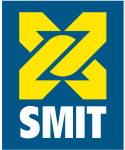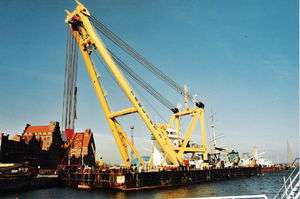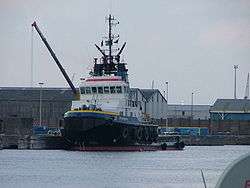Smit International
Smit Internationale N.V. (or Smit International) is a Dutch company operating in the maritime sector. The company was founded in 1842 by Fop Smit as a towage company with only the 140 horsepower paddle steamer tug Kinderdijk. Fop's sons, Jan and Leendert, continued the company under the name L.Smit &Co and expanded the fleet. In 1870, they began using tugs with propellers. After a merger in 1923 with Internationale Sleepdienst, the name was changed to "L. Smit & Co.'s Internationale Sleepdienst". Formerly listed at the NYSE Euronext stock exchange in Amsterdam, the company was fully acquired by Royal Boskalis Westminster in 2010.[3]
 | |
| Wholly owned subsidiary | |
| ISIN | NL0000383800 |
| Industry | Maritime services |
| Founded | 1842 |
| Founder | Fop Smit |
| Headquarters | Rotterdam, Netherlands |
Key people | Frank Verhoeven (Chairman) |
| Services | Towage, salvage, transportation, heavy lifting vessels |
| Revenue | €589.0 million (2009)[1] |
| €104.6 million (2009)[1] | |
| €102.4 million (2009)[1] | |
| Owner | Royal Boskalis Westminster |
Number of employees | 3,620 (2009)[1] |
| Website | www.smit.com |


Takeover
Dutch marine engineer Boskalis made an indicative €1.11 billion takeover offer for Smit on 15 September 2008.[4] Despite the offer being promptly rejected by Smit's board, Boskalis subsequently built a stake of over 25% in the firm[5] and expressed a continuing desire to buy a number of its business units.[6] A revised offer from Boskalis of €1.35 billion, coupled with a pledge to retain the Smit name and its distinct operations, was accepted by the firm's board in January 2010, with Boskalis declaring its offer unconditional that March having reached share ownership of 90%.[7] Smit's shares were delisted from the Amsterdam Stock Exchange on 4 May 2010.[8]
Corporate structure
The company consist of four divisions, in order of revenue:
- Transport & Heavy Lift (33.5% of total revenues)
- Salvage (23.9%)
- Harbour Towage (22.8%)
- Terminals (19.8%)
For larger (salvaging) projects the company often uses joint-ventures or combinations for such a specific project. An example of this is Combinatie Berging Tricolor (Dutch for Combination Salvaging Tricolor) which was created solely for the lifting of the MV Tricolor. A similar multi-firm arrangement was made for the 2013-2014 salvage of the Costa Concordia passenger cruise ship.
Fleet list
For these three businesses Smit (together with its daughter companies and the joint-ventures that are controlled by Smit) has an extensive fleet of 408 ships as per 1 March 2009[9]
| Type of vessel details on power, tonnage etc. |
Harbour Towage | Terminals | Transport & Heavy Lift |
Total[9] |
|---|---|---|---|---|
| Ocean-going tug 14000-26000 hp | 3 | 3 | ||
| Ocean-going tug 6140 hp | 1 | 1 | ||
| Anchor handling tugs 10000-15000 hp | 2 | 2 | 4 | |
| Anchor handling tugs 8000 hp | 2 | 4 | 6 | |
| Anchor handling tugs 3000-8000 hp | 1 | 20 | 21 | |
| Diving support vessel | 2 | 2 | ||
| Utility vessels | 5 | 5 | ||
| Floating sheerlegs seagoing, 3200 tonnes | 1 | 1 | ||
| Floating sheerlegs seagoing, <3200 tonnes | 8 | 8 | ||
| Pulling barges | 2 | 2 | ||
| Seagoing barges 24000 tonnes | 3 | 3 | ||
| Seagoing barges 1000-14000 tonnes | 2 | 1 | 3 | |
| Seagoing barges 1000-8000 tonnes | 10 | 19 | 29 | |
| Inland barges 100-2000 tonnes | 28 | 26 | 54 | |
| Coastal/harbour tugs 3000-6000 hp | 109 | 31 | 2 | 142 |
| Coastal/harbour tugs 1000-3000 hp | 37 | 4 | 2 | 43 |
| Harbour/river tugs 100-1000 hp | 9 | 2 | 1 | 12 |
| Harbour/river pusher tugs 480-2800 hp | 5 | 5 | ||
| Various vessels work-vessels, oil containment vessels etc. | 17 | 18 | 29 | 38 |
| Total fleet | 213 | 60 | 135 | 480 |
High profile operations
Its marine salvage division was involved in several high-profile salvage operations, including:[10]
- SS London Valour[11] (1971–72)
- MT Betelgeuse (1979–80)
- MS Herald of Free Enterprise (1987)
- The Russian submarine Kursk (lifting vessel) (2000)
- Ehime Maru (2001)
- MV Prestige (2002)
- MV Tricolor (lifting vessel) (2002–2003)
- MV Rocknes (2004)
- MV Mighty Servant 3 (2006)
- MS UND Adriyatik (2008)
- MS Costa Concordia (oil containment) (2012)
- USS Guardian (grounded in Philippines) (2013)
- MOL Comfort mysteriously sunk in June 2013.
Internationally, Smit International is known mostly for its expertise in salvage operations.
Often unrealized is the environmental importance of oil removal in many salvage operations. Smit International has dedicated much research into their modern equipment used to extract remaining oil of sunken vessels. They have also partnered with the French firm JLMD System to support preinstalled fast oil recovery systems, which assure quick reliable oil removal in the event of a shipping accident.
References
- "Annual Report 2009" (PDF). Smit International. Archived from the original (PDF) on 2011-07-17. Retrieved 2010-05-07.
- "Archived copy" (PDF). Archived from the original (PDF) on 2014-10-24. Retrieved 2015-02-24.CS1 maint: archived copy as title (link)
- "Smit's World-History". Archived from the original on 8 February 2012. Retrieved 4 October 2011.
- Kreijger, Gilbert; ten Wolde, Harro (15 September 2008). "Boskalis plans 1.1 bln euro bid for Smit". Reuters. Retrieved 1 October 2010.
- Gray-Block, Aaron (2 February 2009). "Boskalis ups stake in Smit, could buy more shares". Reuters. Retrieved 2009-05-30.
- van Tartwijk, Maarten (14 May 2009). "Boskalis CEO: Ambition To Buy Several Smit Units". Dow Jones Newswires. The Wall Street Journal. Retrieved 2009-05-30.
- Roumeliotis, Greg (27 March 2010). "Boskalis clears Smit takeover milestone". Reuters. Retrieved 29 March 2010.
- "Application made for delisting Smit" (Press release). Boskalis. 7 April 2010. Retrieved 7 May 2010.
- Official Fleetlist per 1 March, 2009 Archived 2011-11-11 at the Wayback Machine as published on companies website, retrieved 12 February 2012
- Smit's website on Salvage projects Archived 2007-06-13 at the Wayback Machine, visited 12 February 2012
- Gatti, Carlo (April 2010). "The running aground and the shipwreck of the British cargo ship "London Valour"". Societa' Capitani e Macchinisti Navali – Camogli. Retrieved 11 April 2013.